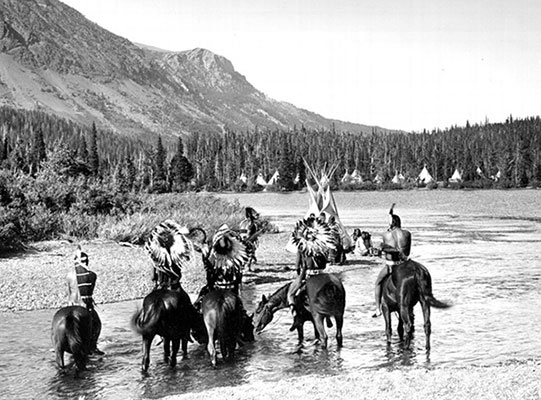Last updated: September 15, 2023
Lesson Plan
Stewards of the Land

- Grade Level:
- Middle School: Sixth Grade through Eighth Grade
- Subject:
- Literacy and Language Arts,Science,Social Studies
- Lesson Duration:
- 60 Minutes
- State Standards:
- CCRA.SL.1;CCRA.SL.2;CCRA.RH/ST.7;CCRA.RH/ST.9;CCRA.WHST.3;CCRA.WHST.4;CCRA.WHST.5;CCRA.WHST;CCRA.WHST.9;Science 1.1.6;Social Studies Standard 3; Social Studies Standard 4;Social Studies Standard 6
- Additional Standards:
- Indian Education for All Seven Essential Understandings Regarding
Montana Indians
Essential Understanding 1 —tribal diversity
Essential Understanding 3 —importance of oral traditions
Essential Understanding 6 —history is subjective
Essential Question
How does the present reflect the impact of the past? What can be done to insure the best possible future for the Earth and all its creatures? What does it mean to be a good steward? Does being a good steward have the same meaning for all cultures- why or why not?
Objective
Students will be able to:
• Name the four tribes most commonly associated with the Glacier area.
• Compare and contrast perspectives about Glacier National Park from the Blackfeet, Kootenai, Salish, Pend d’Oreille, National Park Service and other park visitors.
• Use their language skills to write a contemporary story dealing with relevant environmental issues that affect their lives.
Background
This lesson is one unit of the Work House: A Glacier National Park Science and Indian Education Program. It can be completed as a stand alone lesson or as part of the greater Work House course.
The full Work House Program is available on Glacier National Park's website.
Background information as well as the full lesson plan can be found as a PDF here.
Preparation
Be familiar with the Background Information from the original PDF of the lesson plan. You may choose to use the student version from the pdf with your class.
Listen to the At Home in This Place videos in advance to make sure they are appropriate for your students.
Materials:
- At Home In This Place. These videos can be watched online.
- Student Reading (Unit 1: People and Glacier National Park)
- Paper, pencils & colored pencils
Lesson Hook/Preview
Students will be creating their own picture books.
Procedure
- Make sure your students know the location of Glacier National Park and the background information about the four tribes - Blackfeet, Salish, Kootenai, and Pend d’Oreille. Share as you feel appropriate for your students, the audio greetings from At Home In This Place and the quotes from the tribes that are in the unit introduction.
- Show students the At Home In This Place videos: Blackfeet- The Park is a Living Creature; Kootenai- One of Our Homelands; Salish and Pend d’Oreille - A Hope for Future Generations.
- After each video, discuss and record the main messages students felt were communicated about people and Glacier National Park today and in the past.
- After watching all three videos and looking at the list of messages from each, circle any that were the same for all three. Did stewardship emerge as a message? Spiritual connections? Walking lightly? Ownership? Responsibility? Other?
- Discuss with students the differences with what has gone on in the past with regard to their environment- particularly in their local area. How does the present reflect the impact of the past? What can be done to insure the best possible future for the Earth and all its creatures? What does it mean to be a good steward? Does being a good steward have the same meaning for all cultures- why or why not?
- Have students do the student reading for unit one (silent reading, in class together, or as homework). Then have them write a story that deals with the environment and teaches a lesson about caring for the Earth in contemporary times. (Similar to the Lucy Lonewalker example story in the reading).
Writing Extension
Students usually enjoy having their stories and pictures collected and bound into a class book. It gives them a real feeling of being published and of being a part of a group effort.
Vocabulary
Blackfeet, ceded strip, descendants, ecosystem, future generations, national park, spirituality, stewardship, walking lightly.
Assessment Materials
Reflection and AssessmentWhen the stories are finished, have the students read their stories to the rest of the class or to let you read the stories to the class. Encourage the students to explain and discuss the issues behind their stories.
Enrichment Activities
- Ranger-Led Field Trips and Service Learning Projects in Glacier National Park.
- Self-Guided Field Trips in Glacier National Park.
- Glacier Institute - geology and other education programs.
- Flathead CORE - outdoor education guide for field trips in the Flathead. Guided Tours - various concession operated - in Glacier National Park.
- Flathead Community of Resource Educators Website - local resource providers, student action projects, and outdoor classrooms near you.
Additional Resources
- MT Historical Society Footlocker available for loan.
- Days of the Blackfeet: a Historical Overview of the Blackfeet Tribe for the K-12 Teachers in the State of Montana- created and produced at the Blackfeet Community College.
- Montana Skies Blackfeet Astronomy- lessons distributed by Montana Office of Public Instruction, Indian Education For All..
- America’s Best Idea - lesson plans from the PBS Ken Burns Series.
- Glacier National Park Conservancy Bookstores - variety of books specific to Glacier National Park.
- Before There Were Parks: Yellowstone & Glacier Through Native EyesMT PBS video, 30 minutes.
- Numerous Social Studies lessons from MT OPI, Indian Education for All.
Contact Information
Email us about this lesson plan
